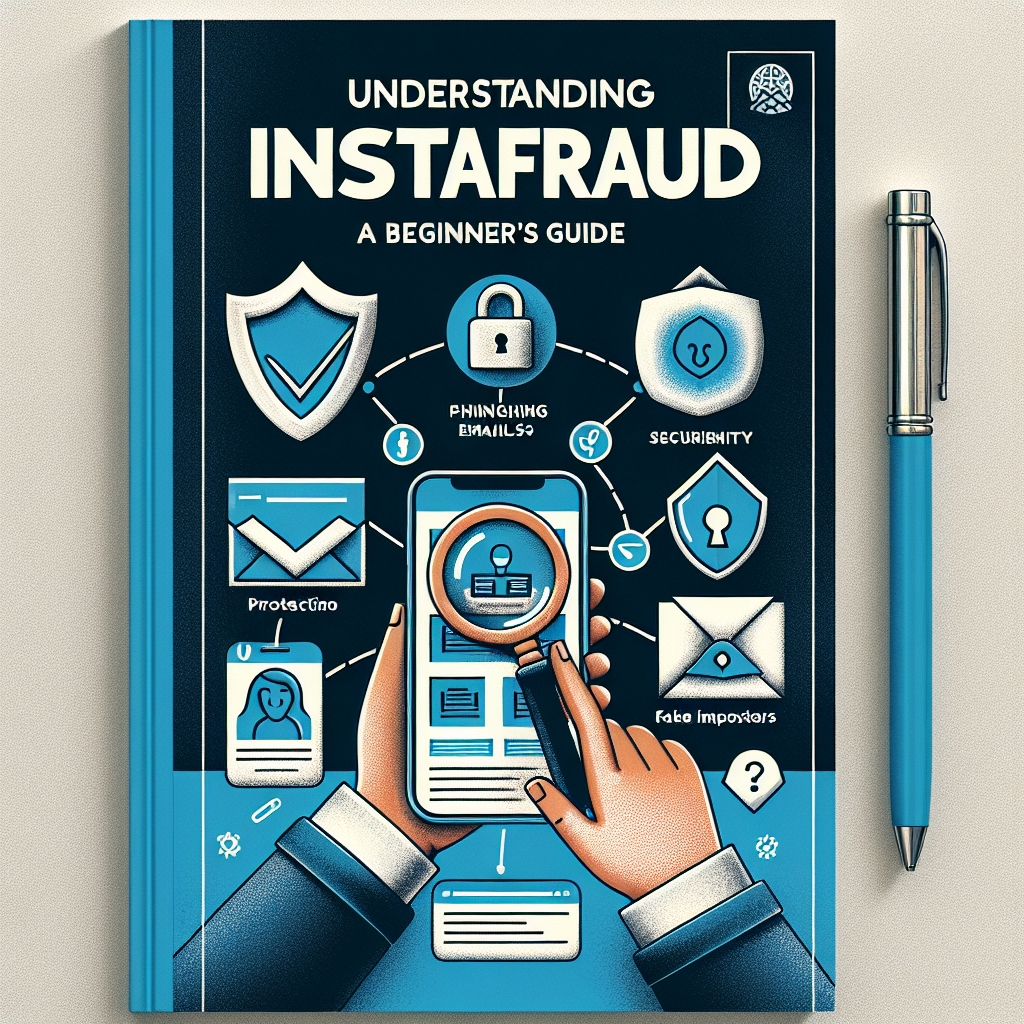Understanding Instafraud: A Beginner’s Guide

In the digital age, social media platforms have become integral to our daily lives, offering unprecedented connectivity and opportunities for personal and professional growth. However, with these opportunities come risks, particularly in the form of online fraud. Instagram, one of the most popular social media platforms, is not immune to these threats. This article aims to provide a comprehensive guide to understanding Instafraud, exploring its various forms, the tactics used by fraudsters, and how users can protect themselves.
What is Instafraud?
Instafraud refers to fraudulent activities conducted on Instagram, where scammers exploit the platform’s features to deceive users for financial gain or personal information. As Instagram continues to grow, so does the sophistication of these scams, making it crucial for users to be aware of the potential dangers.
The Rise of Instagram and Its Vulnerabilities
Instagram’s rapid growth has made it a prime target for fraudsters. With over a billion active users, the platform offers a vast pool of potential victims. The visual nature of Instagram, combined with its emphasis on personal branding and influencer culture, creates an environment ripe for deception.
Fraudsters exploit Instagram’s vulnerabilities by creating fake profiles, impersonating brands or celebrities, and using direct messaging to initiate scams. The platform’s algorithm-driven content discovery can also inadvertently promote fraudulent accounts, increasing their reach and credibility.
Common Types of Instafraud
Instafraud can take many forms, each with its own tactics and objectives. Some of the most common types include:
- Phishing Scams: Fraudsters send direct messages or comments with links to fake websites designed to steal login credentials or personal information.
- Fake Influencer Scams: Scammers create fake influencer profiles to promote counterfeit products or services, often requesting payment upfront.
- Investment Scams: Users are lured into fake investment opportunities with promises of high returns, only to lose their money.
- Romance Scams: Fraudsters create fake profiles to build romantic relationships with victims, eventually asking for money or gifts.
- Giveaway Scams: Scammers promise prizes or gifts in exchange for personal information or a small fee, which they never deliver.
Case Studies: Real-World Examples of Instafraud
To better understand the impact of Instafraud, let’s examine some real-world examples:
In 2020, a fake account impersonating a well-known fashion brand conducted a giveaway scam, promising followers a chance to win expensive merchandise. The account amassed thousands of followers before Instagram shut it down, but not before many users had shared personal information.
Another case involved a fake cryptocurrency investment scheme promoted by a fraudulent influencer account. The scam promised high returns on investments, attracting hundreds of victims who collectively lost millions of dollars.
The Psychology Behind Instafraud
Understanding the psychology behind Instafraud can help users recognize and avoid scams. Fraudsters often exploit emotions such as trust, fear, and greed to manipulate their victims.
For example, scammers may create a sense of urgency by claiming that an offer is time-sensitive, pressuring users to act quickly without verifying the legitimacy of the opportunity. They may also use social proof, such as fake testimonials or follower counts, to build credibility and trust.
By understanding these psychological tactics, users can better protect themselves from falling victim to Instafraud.
How to Protect Yourself from Instafraud
While Instafraud is a growing threat, there are steps users can take to protect themselves:
- Verify Accounts: Always verify the authenticity of accounts, especially those claiming to represent brands or celebrities. Look for the verified badge and check for inconsistencies in the profile.
- Be Skeptical of Offers: If an offer seems too good to be true, it probably is. Be cautious of unsolicited messages or comments promoting giveaways, investments, or products.
- Protect Personal Information: Never share personal information, such as passwords or financial details, with unknown accounts.
- Report Suspicious Activity: Use Instagram’s reporting features to flag suspicious accounts or content, helping to protect the community.
- Educate Yourself: Stay informed about the latest scams and tactics used by fraudsters to better recognize potential threats.
The Mechanics of Instafraud
Understanding the mechanics of Instafraud is crucial for identifying and preventing scams. This section delves into the methods and tools used by fraudsters to execute their schemes on Instagram.
Creating Fake Profiles
One of the most common tactics used in Instafraud is the creation of fake profiles. Fraudsters often use stolen images and information to create convincing personas that can deceive unsuspecting users.
These fake profiles may impersonate real individuals, such as celebrities or influencers, or they may be entirely fictitious. In either case, the goal is to build credibility and trust with potential victims.
Fraudsters may also use automated tools, known as bots, to create and manage multiple fake accounts simultaneously. These bots can like, comment, and follow other users, making the fake profiles appear more legitimate.
Exploiting Instagram Features
Instagram’s features, such as direct messaging and Stories, can be exploited by fraudsters to conduct scams. Direct messaging allows scammers to communicate privately with potential victims, making it easier to manipulate and deceive them.
Stories, which disappear after 24 hours, can be used to promote scams without leaving a permanent trace. Fraudsters may use Stories to advertise fake giveaways or investment opportunities, reaching a wide audience quickly.
Additionally, Instagram’s algorithm-driven content discovery can inadvertently promote fraudulent accounts, increasing their visibility and reach.
Using Social Engineering Tactics
Social engineering is a key component of many Instafraud schemes. Fraudsters use psychological manipulation to trick users into divulging personal information or taking actions that benefit the scammer.
Common social engineering tactics include:
- Impersonation: Pretending to be someone the victim knows or trusts, such as a friend or family member.
- Authority: Claiming to be a representative of a reputable organization or brand.
- Scarcity: Creating a sense of urgency by suggesting that an offer is limited or time-sensitive.
- Reciprocity: Offering something of value, such as a prize or discount, in exchange for information or action.
Leveraging Third-Party Tools
Fraudsters often use third-party tools to enhance their scams. These tools can automate various aspects of the scam, making it easier to manage and scale.
For example, bots can be used to automate the creation and management of fake profiles, while phishing kits can generate convincing fake websites designed to steal login credentials or personal information.
Fraudsters may also use data scraping tools to collect information from Instagram profiles, which can be used to tailor scams to specific individuals or groups.
Monetizing Instafraud
The ultimate goal of Instafraud is often financial gain. Fraudsters use various methods to monetize their scams, including:
- Direct Payments: Convincing victims to send money directly to the scammer, often through payment apps or cryptocurrency.
- Data Theft: Stealing personal information that can be sold on the dark web or used for identity theft.
- Affiliate Marketing: Promoting products or services through affiliate links, earning a commission for each sale.
- Ad Revenue: Generating traffic to websites that display ads, earning revenue from clicks or impressions.
The Impact of Instafraud
Instafraud not only affects individual users but also has broader implications for businesses, brands, and the platform itself. This section explores the various impacts of Instafraud and the challenges it presents.
Financial Losses for Victims
The most immediate impact of Instafraud is financial loss for victims. Scams can result in significant monetary losses, with victims often having little recourse for recovery.
For example, investment scams can lead to substantial financial losses, as victims are tricked into investing in non-existent opportunities. Similarly, romance scams can result in victims sending large sums of money to fraudsters posing as romantic partners.
The emotional toll of these scams can be just as devastating, with victims experiencing feelings of betrayal, shame, and embarrassment.
Reputational Damage for Brands
Instafraud can also have serious consequences for brands and businesses. Fraudsters may impersonate legitimate brands to conduct scams, damaging the brand’s reputation and eroding consumer trust.
For example, a fake account impersonating a well-known brand may conduct a giveaway scam, leading to negative publicity and customer dissatisfaction. Brands may also face legal and regulatory challenges if they fail to adequately protect their customers from fraud.
To mitigate these risks, brands must actively monitor their online presence and take steps to protect their reputation.
Challenges for Instagram
As a platform, Instagram faces significant challenges in combating Instafraud. The sheer volume of content and users makes it difficult to identify and remove fraudulent accounts and content.
Instagram has implemented various measures to address these challenges, such as automated detection systems and user reporting features. However, fraudsters continue to adapt and evolve their tactics, making it an ongoing battle for the platform.
Instagram must balance the need for security with user privacy and freedom of expression, making it a complex issue to navigate.
The Role of Law Enforcement
Law enforcement agencies play a crucial role in combating Instafraud, but they face significant challenges in investigating and prosecuting these crimes.
The global nature of Instagram means that fraudsters can operate from anywhere in the world, making it difficult for law enforcement to track and apprehend them. Additionally, the anonymity provided by the internet can make it challenging to identify and prosecute perpetrators.
Despite these challenges, law enforcement agencies continue to work with social media platforms and other stakeholders to combat online fraud and protect users.
The Importance of User Education
User education is a critical component in the fight against Instafraud. By raising awareness and providing users with the knowledge and tools to protect themselves, the impact of these scams can be significantly reduced.
Educational initiatives can take many forms, including online resources, workshops, and public awareness campaigns. Social media platforms, brands, and law enforcement agencies all have a role to play in promoting user education and fostering a safer online environment.
Preventing Instafraud: Best Practices
Prevention is key when it comes to Instafraud. By adopting best practices and staying vigilant, users can significantly reduce their risk of falling victim to scams. This section outlines some of the most effective strategies for preventing Instafraud.
Strengthening Account Security
One of the most important steps users can take to protect themselves from Instafraud is to strengthen their account security. This includes:
- Using Strong Passwords: Create complex passwords that are difficult for fraudsters to guess. Avoid using easily accessible information, such as birthdays or names.
- Enabling Two-Factor Authentication: Add an extra layer of security by requiring a second form of verification, such as a text message code, when logging in.
- Regularly Updating Passwords: Change passwords periodically to reduce the risk of unauthorized access.
Being Cautious with Personal Information
Users should be cautious about sharing personal information on Instagram, as fraudsters can use this information to conduct scams. Best practices include:
- Limiting Profile Visibility: Set profiles to private to control who can see personal information and posts.
- Avoiding Oversharing: Be mindful of the information shared in posts and Stories, as fraudsters can use this information to tailor scams.
- Being Skeptical of Requests: Be wary of unsolicited requests for personal information, even if they appear to come from trusted sources.
Recognizing Red Flags
Being able to recognize red flags is crucial for identifying potential scams. Some common warning signs include:
- Unverified Accounts: Be cautious of accounts that lack a verified badge, especially if they claim to represent well-known brands or individuals.
- Unsolicited Messages: Be wary of unsolicited messages or comments promoting offers, giveaways, or investment opportunities.
- Pressure to Act Quickly: Scammers often create a sense of urgency to pressure victims into making hasty decisions.
- Requests for Payment or Information: Be cautious of requests for payment or personal information, especially if they come from unknown accounts.
Reporting Suspicious Activity
Reporting suspicious activity is an important step in combating Instafraud. By reporting fraudulent accounts and content, users can help protect the community and prevent others from falling victim to scams.
Instagram provides various reporting features that allow users to flag suspicious accounts, posts, and messages. Users should familiarize themselves with these features and use them whenever they encounter potential scams.
Staying Informed
Staying informed about the latest scams and tactics used by fraudsters is essential for protecting against Instafraud. Users can stay informed by:
- Following Trusted Sources: Follow reputable sources, such as cybersecurity experts and official Instagram accounts, for updates on the latest threats.
- Participating in Educational Initiatives: Take advantage of workshops, webinars, and other educational resources to learn more about online security.
- Engaging with the Community: Share experiences and insights with other users to raise awareness and promote a safer online environment.
The Future of Instafraud
As technology continues to evolve, so too will the tactics used by fraudsters. This section explores the future of Instafraud and the steps that can be taken to address emerging threats.
The Role of Artificial Intelligence
Artificial intelligence (AI) is playing an increasingly important role in both perpetrating and combating Instafraud. Fraudsters are using AI to create more convincing fake profiles and automate various aspects of their scams.
However, AI also offers powerful tools for detecting and preventing fraud. Instagram and other platforms are leveraging AI to identify suspicious activity and remove fraudulent accounts more efficiently.
As AI technology continues to advance, it will be crucial for platforms to stay ahead of fraudsters by developing and implementing sophisticated AI-driven security measures.
The Impact of Emerging Technologies
Emerging technologies, such as blockchain and biometrics, have the potential to significantly impact the landscape of Instafraud. Blockchain technology, for example, offers a decentralized and transparent way to verify identities and transactions, reducing the risk of fraud.
Biometric authentication, such as facial recognition or fingerprint scanning, can provide an additional layer of security for user accounts, making it more difficult for fraudsters to gain unauthorized access.
As these technologies become more widely adopted, they may offer new opportunities for preventing and combating Instafraud.
The Importance of Collaboration
Collaboration between social media platforms, law enforcement agencies, and other stakeholders is essential for effectively addressing Instafraud. By working together, these entities can share information, resources, and best practices to combat online fraud more effectively.
Public-private partnerships can also play a crucial role in developing and implementing innovative solutions to address emerging threats. By fostering collaboration and cooperation, stakeholders can create a safer online environment for all users.
The Role of Regulation
Regulation can play an important role in addressing Instafraud by establishing clear guidelines and standards for social media platforms and other stakeholders. Regulatory frameworks can help ensure that platforms take appropriate measures to protect users and prevent fraud.
However, regulation must be carefully balanced with user privacy and freedom of expression. Policymakers must work closely with industry stakeholders to develop regulations that effectively address the challenges of Instafraud without stifling innovation or infringing on user rights.
The Need for Ongoing Education
As the tactics used by fraudsters continue to evolve, ongoing education will be essential for protecting users from Instafraud. Educational initiatives must be regularly updated to reflect the latest threats and best practices for online security.
By prioritizing user education and awareness, stakeholders can empower individuals to protect themselves and contribute to a safer online community.
Conclusion
Instafraud is a complex and evolving threat that poses significant challenges for users, brands, and social media platforms. By understanding the various forms of Instafraud, the tactics used by fraudsters, and the steps that can be taken to protect against these scams, users can significantly reduce their risk of falling victim.
As technology continues to advance, it will be crucial for stakeholders to stay ahead of emerging threats by leveraging innovative solutions and fostering collaboration. By prioritizing user education and awareness, we can create a safer online environment for all.
Ultimately, the fight against Instafraud requires a collective effort from individuals, businesses, and platforms. By working together, we can protect ourselves and our communities from the dangers of online fraud.





